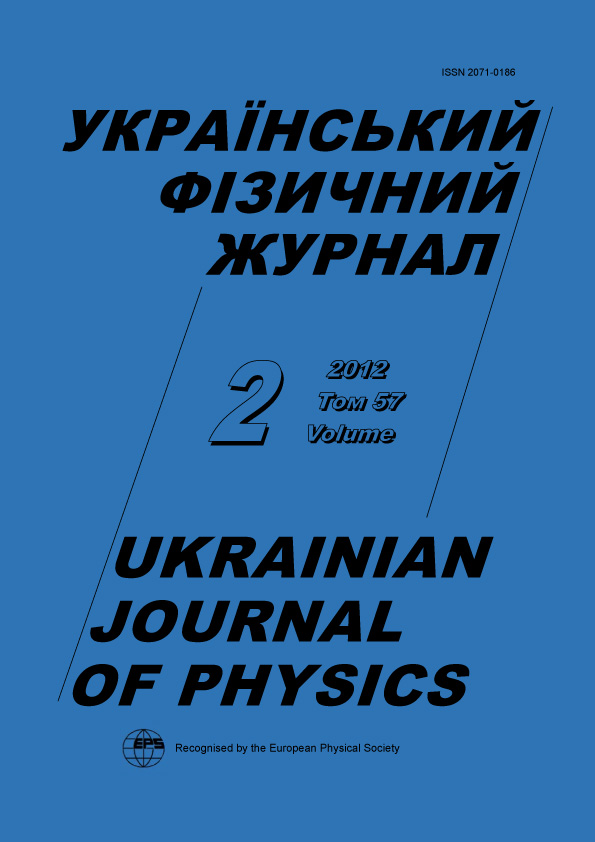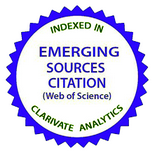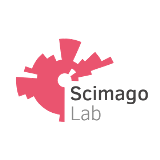Raman Spectra and Intermolecular Hydrogen Bonds of Quinoline in Solutions
DOI:
https://doi.org/10.15407/ujpe57.2.248Keywords:
-Abstract
The half-widths of the 1014- and 1033 cm–1 bands of the Raman spectrum of quinoline at its dilution in neutral solvents (benzene, CCl4) are narrowed by 1.3-1.5 times at high dilutions. This effect is associated with the increased time of the vibrational relaxation. For the 520 cm–1 band in pure liquid quinoline, the parallel polarized component at 20 ºC is asymmetric in the high-frequency region. The shape of the perpendicular polarized component is complicated. A non-coincidence of the peak frequencies of the parallel and perpendicular polarized components is observed (~2 cm–1). Quantum-chemical calculations showed that, in the region of 520 cm–1 for a monomer molecule, we should really have two near located lines with the wavenumbers 530 and 527 cm–1 (scaling factor 0.97), and with the depolarization ratios 0.61 and 0.26. In the solutions with propan-2-ol, the 1033.8 cm–1 band becomes of a doublet character. The resolution of the doublet becomes better by the dilution of a binary quinoline-alcohol solution with a large amount of a neutral solvent (benzene). The wavenumbers of bands in the triple mixture are 1033 cm–1 and 1039 cm–1. The doublet nature of the band in the binary and triple mixtures is associated with the presence of monomer molecules and quinoline-propan-2-ol aggregates (the high-frequency line) in the liquid mixture. Quantum-chemical calculations showed that the hydrogen bonds with a length of 1.958 Å and an energy gain of 22.0 kJ/mole can be formed between molecules of quinoline and alcohol. The formation of aggregates can be also detected in the 820 cm–1 band of propan-2-ol. A similar picture is observed for the 667 cm–1 band of chloroform in its solution with quinoline.
References
G.A. Jeffrey and W. Saenger, Hydrogen Bonding in Biological Structures (Springer, Berlin, 1991).
https://doi.org/10.1007/978-3-642-85135-3
G.C. Pimentel and A.L. McClellan, The Hydrogen Bond (Freeman, San Francisco, 1960).
C.L. Perrin and J.B. Nielson, Annu. Rev. Phys. Chem. 48, 511 (1997).
https://doi.org/10.1146/annurev.physchem.48.1.511
X. Wu, Y. Chen, and T. Yamaguchi, J. Mol. Spectr. 246, 187 (2007).
https://doi.org/10.1016/j.jms.2007.09.012
T. Scharge, D. Luckhaus, M. A. Suhm, Chem. Phys. 346, 167 (2008).
https://doi.org/10.1016/j.chemphys.2008.01.028
K. Suhara, A. Fujii, K. Mizuse, and N. Mikami, J. Chem. Phys. 126, 194306 (2007).
https://doi.org/10.1063/1.2734969
R. Wugt Larsen, P. Zielke, and M.A. Suhm, J. Chem. Phys. 126, 94307 (2007).
https://doi.org/10.1063/1.2732745
L. Zoranic, F. Sokolic, and A. Perera, J. Chem. Phys. 127, 024502 (2007).
https://doi.org/10.1063/1.2753482
E.F. Fileti, M. Castro, and S. Canuto, Chem. Phys. Lett. 452, 54 (2008); 127, 024502 (2007).
https://doi.org/10.1016/j.cplett.2007.12.059
E.I. Doroshenko, O. Lizengevóch, V. Pogorelov, and L. Savransky, Ukr. J. Phys. 49, 540 (2004).
S. Boyd and R. Boyd, J. Chem. Theory Comput. 3, 54 (2007).
https://doi.org/10.1021/ct6002912
T.N. Wassermann, P. Zielke, J.J. Lee, C. Cezard, and M.A. Suhm, J. Phys. Chem. A 111, 7437 (2007).
https://doi.org/10.1021/jp071008z
Y. Liu, S. Consta, F. Ogeer, Y.J. Shi, and R.H. Lipson, Can. J. Chem. 85, 843 (2007).
https://doi.org/10.1139/v07-104
C.Cezard, C.A. Rice, M.A. Suhm, J. Phys. Chem. A, 110, 9839 (2006).
https://doi.org/10.1021/jp0610362
F.H. Tukhvatullin, V.E. Pogorelov, A. Jumabaev, H.A. Hushvaktov, A.A. Absanov, and A. Shaymanov, J. Mol. Struct. 881, 52 (2008).
https://doi.org/10.1016/j.molstruc.2007.08.036
Y. Tamenori, K. Okada, O. Takahashi, S. Arakawa, K. Tabayashi, A. Hiraya, T. Gejo, and K. Honma, J. Chem. Phys. 128, 124321 (2008).
https://doi.org/10.1063/1.2898536
G.-J. Zhao and K.-L. Han, J. Phys. Chem. A 111, 2469 (2007).
https://doi.org/10.1021/jp068420j
G.-J. Zhao, J.-Y. Liu, L.-C. Zhou, and K.-L. Han, J. Phys. Chem. B 111, 8940 (2007).
https://doi.org/10.1021/jp0734530
G.-J. Zhao and K.-L. Han, Biophys. J. 94, 1, 38 (2008).
https://doi.org/10.1529/biophysj.107.113738
F.H. Tukhvatullin, V.Ye. Pogorelov, A. Jumabaev, H.A. Hushvaktov, A.A. Absanov, and A. Usarov, J. Mol. Liq. 160, 88 (2011).
https://doi.org/10.1016/j.molliq.2011.02.015
V. Pogorelov, L. Bulavin, I. Doroshenko, O. Fesjun, and O. Veretennikov, J. Mol. Struct. 708, 61 (2004).
https://doi.org/10.1016/j.molstruc.2004.03.003
V. Pogorelov, A. Yevglevsky, I. Doroshenko, L. Berezovchuk, and Yu. Zhovtobryuch, Superlatt. Microstr. 4, 571 (2008).
https://doi.org/10.1016/j.spmi.2008.01.014
².Yu. Doroshenko, À.². Lizengevych, V.E. Pogorelov, and L.I. Savransky, Visn. Kiev. Univ. Ser. Fiz. Mat. Nauky 8-9, 19 (2008).
V. Pogorelov, I. Doroshenko, P. Uvdal, V. Balevicius, and S. Sablinskas, Mol. Phys. 108, 2165 (2010).
https://doi.org/10.1080/00268976.2010.494629
S. Schlund, M. Mladenovic, E.M. Basilio Janke, B. Engels, and K. Weisz, J. Am. Chem. Soc. 127, 16151 (2005).
https://doi.org/10.1021/ja0531430
H.S. Andrei, N. Solca, and O. Dopfer, Chem. Phys. Chem. 7, 107 (2006).
https://doi.org/10.1002/cphc.200500432
D.K. Singh, S.K. Srivastava, S. Schlucker, R.K. Singh, and B.P. Asthana, J. Raman Spectrosc. 42, 851 (2011).
https://doi.org/10.1002/jrs.2779
V. Deckret, B.P. Asthana, P.C. Mishra, and W. Kiefer, J. Raman Spectrosc. 27, 907 (1996).
https://doi.org/10.1002/(SICI)1097-4555(199612)27:12<907::AID-JRS52>3.0.CO;2-#
R.K. Singh, S.K. Srivastava, A.K. Ojha, U. Arvind, and B.P. Asthana, J. Raman Spectrosc., 37, 76 (2006).
https://doi.org/10.1002/jrs.1474
A.K. Ojha, S.K. Srivastava, S. Schlucker, W. Kiefer, B.P. Asthana, and R.K. Singh, J. Raman Spectrosc. 38, 1656 (2007).
https://doi.org/10.1002/jrs.1885
F.H. Tukhvatullin, A. Jumabaev, G. Muradov, H.A. Hushvaktov, and A.A. Absanov, J. Raman spectrosc. 10, 932 (2005).
https://doi.org/10.1002/jrs.1386
M. Bolboaca, W. Kiefer, and J. Popp, J. Raman Spectrosc. 33, 207 (2002).
https://doi.org/10.1002/jrs.816
P. Sett, M. Ghosh, P.K. Mallick, and J. Chowdhury, J. Raman Spectrosc. 39, 1878 (2008).
https://doi.org/10.1002/jrs.2054
M. Balón, P. Guardado, M.A. Muñoz, and C. Carmona, Biospectr. 4, Issue 3, 185 (1998).
https://doi.org/10.1002/(SICI)1520-6343(1998)4:3<185::AID-BSPY4>3.0.CO;2-3
K. Tanabe and J. Hiraichi, Spectrochim. Acta. A36, 341 (1980).
https://doi.org/10.1016/0584-8539(80)80141-3
M.J. Frisch, G.W. Trucks, H.B. Schlegel, G.E. Scuseria, M.A. Robb, J.R. Cheeseman, V.G. Zakrzewski, J.A. Montgomery, Jr., R.E. Stratmann, J.C. Burant, S. Dapprich, J.M. Millam, A.D. Daniels, K.N. Kudin, M.C. Strain, O. Farkas, J. Tomasi, V. Barone, M. Cossi, R. Cammi, B. Mennucci, C. Pomelli, C. Adamo, S. Clifford, J. Ochterski, G.A. Petersson, P.Y. Ayala, Q. Cui, K. Morokuma, D. K. Malick, A.D. Rabuck, K. Raghavachari, J.B. Foresman, J. Cioslowski, J.V. Ortiz, B.B. Stefanov, G. Liu, A. Liashenko, P. Piskorz, I. Komaromi, R. Gomperts, R.L. Martin, D.J. Fox, T. Keith, M.A. Al-Laham, C.Y. Peng, A. Nanayakkara, C. Gonzalez, M. Challacombe, P.M.W. Gill, B. Johnson, W. Chen, M.W. Wong, J.L. Andres, C. Gonzalez, M. Head-Gordon, E.S. Replogle, and J.A. Pople, Gaussian 98, Revision A.3 (Gaussian, Pittsburgh, 1998).
V.I. Korsunskiy, N.L. Lavrik, and Y.I. Naberukhin, Zh. Opt. Spektrosk. 41, 794 (1976).
C. Perchard and J.P. Perchard, Chem. Phys. Lett. 27, 445 (1974).
https://doi.org/10.1016/0009-2614(74)90262-0
G. Fini and P. Mirone, J. Chem. Soc. Faraday Trans. 2. 70, 1776 (1974).
https://doi.org/10.1039/F29747001776
P. Mirone and G. Fini, J. Chem. Phys. 71, 2241 (1979).
https://doi.org/10.1063/1.438557
G. Fini and P. Mirone, Spectrochim. Acta Part. A 32, 625 (1976).
https://doi.org/10.1016/0584-8539(76)80125-0
C. Perchard and J.P. Perchard, J. Raman Spectrosc. 3, 277 (1975).
https://doi.org/10.1002/jrs.1250030216
C. Perchard and J.P. Perchard, J. Raman Spectrosc. 6, 74 (1975).
https://doi.org/10.1002/jrs.1250060205
M. Schwarz and C.H. Wang, Chem. Phys. Lett. 25, 26 (1974).
https://doi.org/10.1088/0031-9112/25/1/032
D.R. Jones, C.H. Wang, D.H. Christensen, and O.F. Nielson, J. Chem. Phys. 64, 4475 (1976).
https://doi.org/10.1063/1.432073
R.J. Bartholomew and D.E. Irish, J. Raman Spectrosc. 29, 115 (1998).
https://doi.org/10.1002/(SICI)1097-4555(199802)29:2<115::AID-JRS201>3.0.CO;2-5
A.K. Atakhodjaev, F.H. Tukhvatullin, A. Jumabayev, and U.N. Tashkenbaev, JETP Letters 51, 509 (1990).
F.H. Tukhvatullin, B.G. Hudayberdiev, A. Jumabaev, H.A. Hushvaktov, and A. Absanov, J. Molec. Liquid 155, 67 (2010).
https://doi.org/10.1016/j.molliq.2010.05.015
F.H. Tukhvatullin, A. Jumabaev, H. Hushvaktov, A. Absanov, and A. Shaymanov, J. Raman Spectrosc. 38, 1633 (2007). https://doi.org/10.1002/jrs.1882
Downloads
Published
How to Cite
Issue
Section
License
Copyright Agreement
License to Publish the Paper
Kyiv, Ukraine
The corresponding author and the co-authors (hereon referred to as the Author(s)) of the paper being submitted to the Ukrainian Journal of Physics (hereon referred to as the Paper) from one side and the Bogolyubov Institute for Theoretical Physics, National Academy of Sciences of Ukraine, represented by its Director (hereon referred to as the Publisher) from the other side have come to the following Agreement:
1. Subject of the Agreement.
The Author(s) grant(s) the Publisher the free non-exclusive right to use the Paper (of scientific, technical, or any other content) according to the terms and conditions defined by this Agreement.
2. The ways of using the Paper.
2.1. The Author(s) grant(s) the Publisher the right to use the Paper as follows.
2.1.1. To publish the Paper in the Ukrainian Journal of Physics (hereon referred to as the Journal) in original language and translated into English (the copy of the Paper approved by the Author(s) and the Publisher and accepted for publication is a constitutive part of this License Agreement).
2.1.2. To edit, adapt, and correct the Paper by approval of the Author(s).
2.1.3. To translate the Paper in the case when the Paper is written in a language different from that adopted in the Journal.
2.2. If the Author(s) has(ve) an intent to use the Paper in any other way, e.g., to publish the translated version of the Paper (except for the case defined by Section 2.1.3 of this Agreement), to post the full Paper or any its part on the web, to publish the Paper in any other editions, to include the Paper or any its part in other collections, anthologies, encyclopaedias, etc., the Author(s) should get a written permission from the Publisher.
3. License territory.
The Author(s) grant(s) the Publisher the right to use the Paper as regulated by sections 2.1.1–2.1.3 of this Agreement on the territory of Ukraine and to distribute the Paper as indispensable part of the Journal on the territory of Ukraine and other countries by means of subscription, sales, and free transfer to a third party.
4. Duration.
4.1. This Agreement is valid starting from the date of signature and acts for the entire period of the existence of the Journal.
5. Loyalty.
5.1. The Author(s) warrant(s) the Publisher that:
– he/she is the true author (co-author) of the Paper;
– copyright on the Paper was not transferred to any other party;
– the Paper has never been published before and will not be published in any other media before it is published by the Publisher (see also section 2.2);
– the Author(s) do(es) not violate any intellectual property right of other parties. If the Paper includes some materials of other parties, except for citations whose length is regulated by the scientific, informational, or critical character of the Paper, the use of such materials is in compliance with the regulations of the international law and the law of Ukraine.
6. Requisites and signatures of the Parties.
Publisher: Bogolyubov Institute for Theoretical Physics, National Academy of Sciences of Ukraine.
Address: Ukraine, Kyiv, Metrolohichna Str. 14-b.
Author: Electronic signature on behalf and with endorsement of all co-authors.













